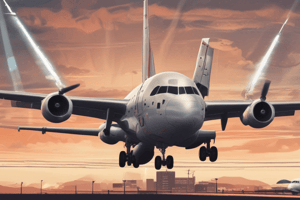Podcast
Questions and Answers
Which airspace classes must have vertical separation provided between IFR flights?
Which airspace classes must have vertical separation provided between IFR flights?
- A, B, and C (correct)
- A and B
- E, F, and G
- C, D, and E
In Indian airspace, which classes are not designated for controlled traffic?
In Indian airspace, which classes are not designated for controlled traffic?
- F and G (correct)
- E and F
- C and D
- A and B
What is the nominal vertical separation for RVSM compliant aircraft above FL290?
What is the nominal vertical separation for RVSM compliant aircraft above FL290?
- 1000 ft (correct)
- 1500 ft
- 2000 ft
- 2500 ft
What should be done if separation between two aircraft is lost due to reasons other than ACAS RA?
What should be done if separation between two aircraft is lost due to reasons other than ACAS RA?
What type of separation should be applied when two aircraft are operating on intersecting tracks with a 90-degree angle?
What type of separation should be applied when two aircraft are operating on intersecting tracks with a 90-degree angle?
In the event of degraded aircraft performance, what should the flight crew do?
In the event of degraded aircraft performance, what should the flight crew do?
What is the wake turbulence separation required for a LIGHT aircraft landing behind a SUPER aircraft?
What is the wake turbulence separation required for a LIGHT aircraft landing behind a SUPER aircraft?
What is the minimum distance required for lateral separation of two aircraft on crossing radials of the same VOR?
What is the minimum distance required for lateral separation of two aircraft on crossing radials of the same VOR?
Which type of airspace allows for a VMC climb and descent?
Which type of airspace allows for a VMC climb and descent?
When using lateral separation, what is the minimum angular difference between tracks of two aircraft using NDB?
When using lateral separation, what is the minimum angular difference between tracks of two aircraft using NDB?
Which is NOT a valid method of applying longitudinal separation?
Which is NOT a valid method of applying longitudinal separation?
During a step climb/descent, what is required to maintain vertical separation?
During a step climb/descent, what is required to maintain vertical separation?
Flashcards
Vertical Separation Mandate
Vertical Separation Mandate
Vertical separation for IFR flights, mainly in airspace classes A, B, and C.
Vertical Separation Minimum (below FL290)
Vertical Separation Minimum (below FL290)
1000 feet minimum below FL290.
Lost Separation Protocol
Lost Separation Protocol
Provide traffic information immediately to affected aircraft.
RVSM Separation
RVSM Separation
Signup and view all the flashcards
Minimum Time Separation (same track, level)
Minimum Time Separation (same track, level)
Signup and view all the flashcards
Lateral Separation Using VORs
Lateral Separation Using VORs
Signup and view all the flashcards
RNAV Route Separation (RNP 4)
RNAV Route Separation (RNP 4)
Signup and view all the flashcards
Degraded Performance Reporting
Degraded Performance Reporting
Signup and view all the flashcards
Intersecting Tracks Separation (90 degrees)
Intersecting Tracks Separation (90 degrees)
Signup and view all the flashcards
Mach Number Technique Separation
Mach Number Technique Separation
Signup and view all the flashcards
Wake Turbulence Separation (Light behind Super)
Wake Turbulence Separation (Light behind Super)
Signup and view all the flashcards
Valid Separation Methods (Degraded Performance)
Valid Separation Methods (Degraded Performance)
Signup and view all the flashcards
Study Notes
Air Traffic Services Key Concepts
- Vertical separation is mandated for IFR flights primarily in airspace classes A, B, and C.
- In India, uncontrolled traffic is designated for airspace classes E and F.
- Below FL290, a vertical separation minimum of 1000 feet is required.
- If separation is lost not due to ACAS RA, traffic information should be provided immediately to the affected aircraft.
- Above FL290, RVSM compliant aircraft require a nominal vertical separation of 1000 feet.
Time and Lateral Separation
- Minimum time separation on the same track at the same level is 10 minutes.
- Lateral separation between aircraft using VORs requires a divergence of at least 15 degrees.
- Cruise climb may be restricted in Indian FIRs at altitudes above FL410.
- A departing aircraft must maintain a time separation of 2 minutes from an arriving aircraft on a complete instrument approach.
RNAV Routes and Separation Standards
- Aircraft using RNAV routes with RNP 4 standards require a minimum lateral separation distance of 10 NM.
- For aircraft climbing on the same track, a separation minimum of 10 NM is applicable.
- An aircraft facing degraded performance must report the issue to ATC without delay.
Intersection and Mach Number Techniques
- When two aircraft are on intersecting tracks at a 90-degree angle, lateral separation must be applied.
- Using the Mach number technique, if the preceding aircraft is Mach 0.02 faster, a minimum time separation of 6 minutes is required.
Communication and Reporting
- Required communication for distance-based separation minima can be through CPDLC.
- Position reports for 50 NM longitudinal separation should be made every 10 minutes.
Wake Turbulence Separation
- Light aircraft landing behind a super aircraft require a wake turbulence separation of 3 minutes.
- For a medium aircraft landing behind a heavy aircraft, a wake turbulence separation of 2 minutes is mandated.
Departure and Reciprocation
- If two departing aircraft follow the same track and one is 40 knots faster, a separation of 1 minute is required.
- Minimum angular difference for lateral separation between two aircraft using NDB is 20 degrees.
Airspace Classifications
- Class E and G airspace allows for VMC climbs and descents.
- Lateral separation of two aircraft on crossing radials of the same VOR requires a minimum of 20 DME.
Valid Separation Methods
- Valid methods for applying longitudinal separation include time-based separation and speed differential.
- Essential traffic information in case of non-maintained minimum separation should include conflicting traffic details.
Handling Degraded Performance
- During degraded aircraft performance, valid separation methods may include lateral separation and radar vectoring.
- For step climbs/descent, progressive assignment of levels is essential to maintain vertical separation.
Studying That Suits You
Use AI to generate personalized quizzes and flashcards to suit your learning preferences.




